



Target audience
| LOCATION | GROUP | LANGUAGE | DATE | TIME (EST) | GROUP COMPOSITION | NUMBER OF PARTICIPANTS |
|---|---|---|---|---|---|---|
| Windsor | 1 | English | July 7 | 5:30-7:30 pm | Receiving CERB | 7 |
| Greater Montreal Area | 2 | French | July 9 | 6:00-8:00 pm | Black Canadians | 7 |
| Ontario – mix of major centres | 3 | English | July 14 | 6:00-8:00 pm | Black Canadians | 7 |
| Winnipeg | 4 | English | July 15 | 7:00-9:00 pm | Parents (gr.7+) | 6 |
| Rural Quebec | 5 | French | July 16 | 5:30-7:30 pm | Receiving CERB | 5 |
| GTA/Hamilton/ Windsor | 6 | English | July 20 | 6:00-8:00 pm | Young Adults (18-24) | 7 |
| Calgary | 7 | English | July 21 | 7:00-9:00 pm | Gen Pop | 5 |
| City of Montreal | 8 | French | July 22 | 6:00-8:00 pm | Gen Pop | 8 |
| Atlantic Canada | 9 | English | July 23 | 4:30-6:30 pm | Gen Pop | 4 |
| City of Toronto | 10 | English | July 27 | 6:00-8:00 pm | Gen Pop | 7 |
| Lower Mainland BC | 11 | English | July 28 | 8:30-10:30 pm | Gen Pop | 7 |
| Quebec – mix of mid-size/smaller towns | 12 | French | July 29 | 6:00-8:00 pm | Parents (JK/K-gr.6) | 6 |
| Total number of participants | 76 | |||||







The figures above show a series of Facebook ads. The ad sponsor for all ads is Healthy Canadians and the Health Canada and Government of Canada logo are included at the bottom of each ad. Each ad also contains a call to action at the bottom that reads “Help us stop COVID-19. Download the COVID Alert app” and includes a button to “Download” the app. Each concept (A to G) contains a different post headline and different main image.
A: Post headline: We need your help to contain the virus. Download the COVID Alert app so that, together, we can limit the spread of COVID-19. Main image has a green background. Main headline (in image): Help stop the spread. Download the COVID Alert app. Icon (in image): Hand holding a cell phone with COVID Alert app logo on screen.
B: Post headline: We need you to do your part to contain the contain virus. Download the COVID Alert app so that, together, we can limit the spread of COVID-19. Main image has a blue background. Main headline (in image): Do your part. Download the COVID Alert app. Icon (in image): A person with a beard is holding a cell phone that is sending an alert. The COVID Alert app logo is shown in a speech bubble.
C: Post headline: Let’s keep protecting ourselves and others. Download the COVID Alert app so that, together, we can limit the spread of COVID-19. Main image has a yellow background. Main headline (in image): Download the COVID Alert app. Protect your community. Icon (in image): Two different hands each holding a cell phone with COVID Alert app logo on screen. There is a network signal that connects the two phones together.
D: Post headline: Break the chain of infection while protecting your privacy. Download the COVID Alert app so that, together, we can limit the spread of COVID-19. Main image has a pink background. Main headline (in image): We protect your privacy so you can protect others. Icon (in image): A person with long hair is holding a cell phone that is sending an alert. The COVID Alert app logo is shown in a speech bubble.
E: Post headline: Protect yourself and your loved ones by knowing if you’ve been exposed. Download the COVID Alert app so that, together, we can limit the spread of COVID-19. Main image has an orange background. Main headline (in image): Use the COVID Alert app to know if you may have been exposed. Icon (in image): A person with an afro is holding a cell phone that is sending an alert. The COVID Alert app logo is shown in a speech bubble.
F: Post headline: Get tested if someone you’ve been near reports positive for the virus. Download the COVID Alert app so that, together, we can limit the spread of COVID-19. Main image has a purple background. Main headline (in image): Download the COVID Alert app before heading out. Icon (in image): A person with short hair is holding a cell phone with a notification symbol. The COVID Alert app logo is shown in a speech bubble.
G: Post headline: Go further than wearing a mask to protect yourself and others. Download the COVID Alert app so that, together, we can limit the spread of COVID-19. Main image has a seafoam green coloured background. Main headline (in image): Get extra protection. Use both a mask and the COVID Alert app. Icon (in image): A person with short hair, wearing a mask, is holding a cell phone that is sending an alert. The COVID Alert app logo is shown in a speech bubble.

The four figures above show a series of screenshots, in sequential order that Canadians would see on the COVID Alert app. Each frame has a ‘Close’ button on the top right, an image, headline and sub-text in the main frame, and at the bottom, there is a progress bar along with ‘Back’ and ‘Next’ buttons to move through from page to page.
1. This image shows a cell phone in a person’s pocket (in purple) that has a sync icon on the screen. Next to the cell phone is a rectangle block of arrows coming into the phone and away from the cell phone (in green). Headline: How COVID Alert works. Sub-text: The app runs in the background and will not interrupt your activities. Whenever you’re near someone else with COVID Alert, both phones exchange random codes every 5 minutes. The random codes change often and cannot be used to identify you.
2. This image shows two cell phones (in purple) connected by a dotted line above with a timer icon in the middle. Above this is a sign (in green) with a dotted double arrow icon. Headline: What’s an exposure? Sub-text: The app estimates how near people are from the strength of Bluetooth signals. If you’re closer than 2 metres for more than 15 minutes, the app will record an exposure.
3. This image shows a cell phone (in purple) with an export icon on the screen. Above this is a rectangle (in green) that shows the code 101101. Above this is an icon of a white cloud. Headline: Getting a positive test. Sub-text: If someone with the app is diagnosed with COVID-19, they can choose to upload the random codes their phone sent. The codes go into a central server. The server only gets the codes. It does not get any information about the person.
4. This image shows a cell phone (in purple) at the bottom. Above the phone is a vertical rectangle (in green) with codes 00100, 01101, 01101. Over the middle code (01101) is a search bar. Headline: Looking for exposures. Sub-text: Every day, whenever it has an Internet connection, your phone will get a list of the random codes from people who reported a diagnosis. If it finds codes that match, the app notifies you that you’ve been exposed and gives you guidance.


The five figures above show a series of screenshots, in sequential order, that Canadians would first see when they download and open the COVID Alert app. Each frame has an image, headline and sub-text in the main frame. At the bottom, there is a progress statement (e.g. Step 1 of 6), along with a ‘Next’ button to move to the next page.
1. This image shows the top of a cell phone (in purple) with icons of people doing different activities above. Headline: Together, let’s stop the spread of COVID-19. Sub-text: COVID Alert helps us break the cycle of infection. The app can let people know of possible exposures before any symptoms appear. That way, we can take care of ourselves and protect our communities.
2. This image shows icons of a corporate building, an apartment building and several houses all connected. Headline: What COVID Alert does not do. Sub-text: The app will not tell you in the moment if you’re currently near someone who’s been diagnosed. It will not tell you about outbreaks in your community.
3. This image shows a silhouette of a person’s face using icons of a hat and glasses (in purple). Above this, is a location services symbol (in red) with an ‘X” through it. Headline: Totally anonymous. Sub-text: COVID Alert does not use GPS or location services. It has no way of knowing: X Your location. X Your name or address. X Your phone’s contacts. X Your health information.
4. This image shows two people holding cell phones and a person with a cell phone in their pockets (in purple). Above each cell phone is a Bluetooth icon (in green). Headline: How it works. Sub-text: ✓ The app uses Bluetooth to exchange random codes with nearby phones. ✓ Every day, it checks a list of random codes from people who tell the app they tested positive. ✓ If you’ve been near one of those codes in the past 14 days, you will get a notification. At the bottom of the frame there is a button that reads ‘Learn more about how it works’ with a forward arrow.
5. This image shows a cell phone (purple). On screen, is a series of text with an ‘X’ (in red) and a ‘✓” (in green) at the bottom. Headline: The app will now ask your permission. Sub-text: Allow the app to start logging random codes or “random IDs” when you’re near other phones. The app will access the date, duration, and signal strength related to the random codes, but they never leave your phone. You’ll also need to enable push notifications. At the bottom of the frame there is a button that reads ‘Learn more about privacy’ with a forward arrow.
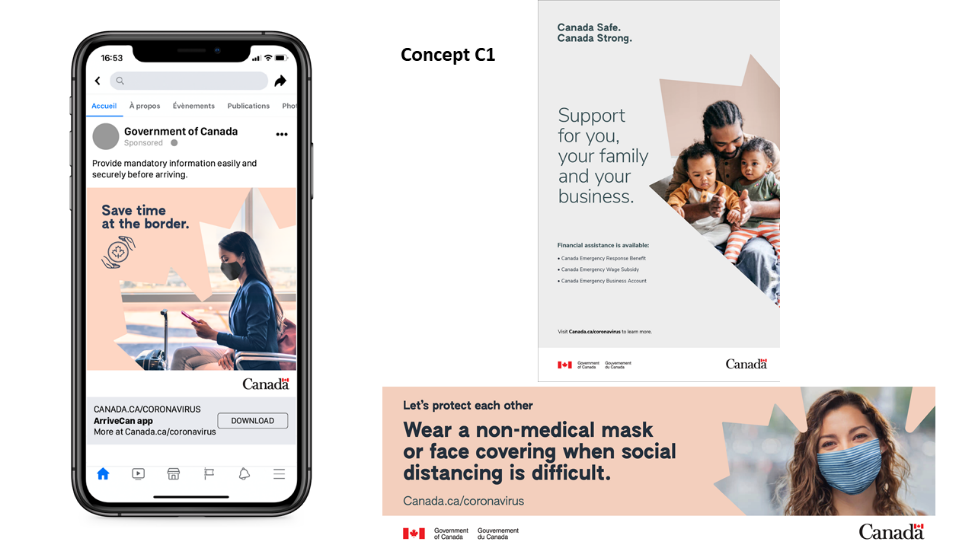
Concept C1: The figure above shows an ad set consisting of three ads over different mediums – Facebook, print and billboard ad. All ads feature a peach and light grey background colour and have a main headline in large black font. The first ad’s (Facebook) main headline (on the left) reads “Save time at the border.” along with a small icon of two hands surrounding a circle with a maple leaf in the middle. The right side of the ad features a photograph of a woman wearing a mask in an airport, which is framed by a maple leaf. At the bottom, there is a button to download the app or find out more information at Canada.ca/coronavirus. The second ad (print) shows (on the right) a large image of a man sitting while holding his two children, which is framed by a partial maple leaf. On the left hand side the main headline reads “Canada Safe. Canada Strong.” and a larger sub headline below reads “Support for you, your family and your business.” Underneath this, is smaller text that reads “Financial assistance is available:” and lists the Canada Emergency Response Benefit, Canada Emergency Wage Subsidy and the Canada Emergency Business Account. At the bottom of the ad the text “Visit Canada.ca/Coronavirus to learn more” and the Government of Canada logo and wordmark are shown. The third ad’s (billboard) main headline reads “Let’s protect each other” and has a sub headline that reads “Wear a non-medical mask or face covering when physical distancing is difficult.” Below this, text with the URL canada.ca/coronavirus is presented. The right hand side of the ad features a photograph of a young man smiling as she is wearing a mask, which is framed by the outline of a maple leaf. At the bottom of the ad, the Government of Canada logo and wordmark are shown.
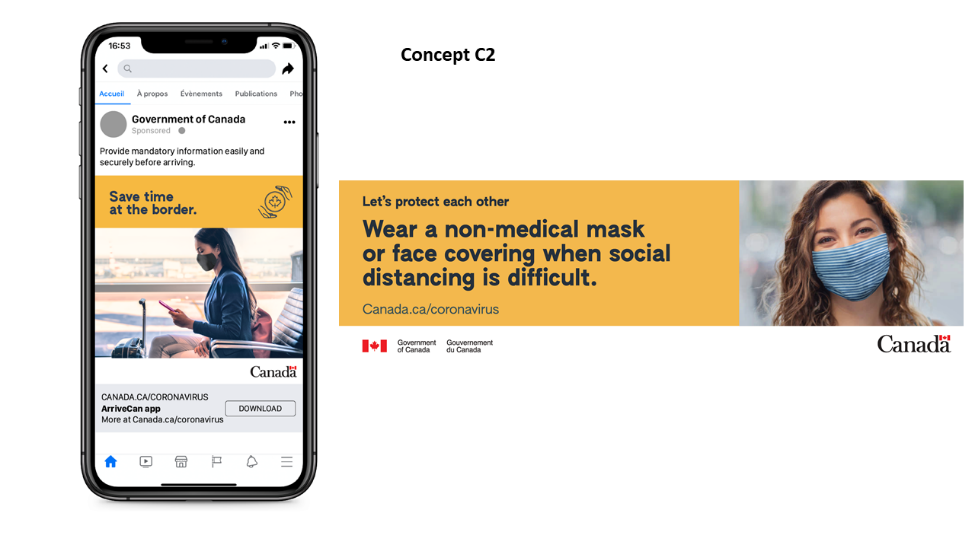
Concept C2: The figure above shows an alternative ad set consisting of two ads over different mediums – Facebook and billboard ad. All ads feature an orange background and have a title headline and/or a main headline in large black font. The first ad’s (Facebook) the main headline reads “Save time at the border.” (on the right) and a black icon of two hands surrounding a circle with a maple leaf in the middle (on the right). Underneath, taking up most of the ad, is a rectangular photograph of a woman wearing a mask in an airport. At the bottom, there is a button to download the app with the text “ArriveCan app” and “More at Canada.ca/coronavirus.” The second ad’s (billboard) title headline reads “Let’s protect each other.” (on the left side) with a main headline below that reads “Wear a non-medical mask or face covering when physical distancing is difficult.” Below this, text with the URL Canada.ca/coronavirus is presented. The right hand side of the ad features a square photograph of a young man smiling as she is wearing a mask. At the bottom of the ad, the Government of Canada logo and wordmark are shown.
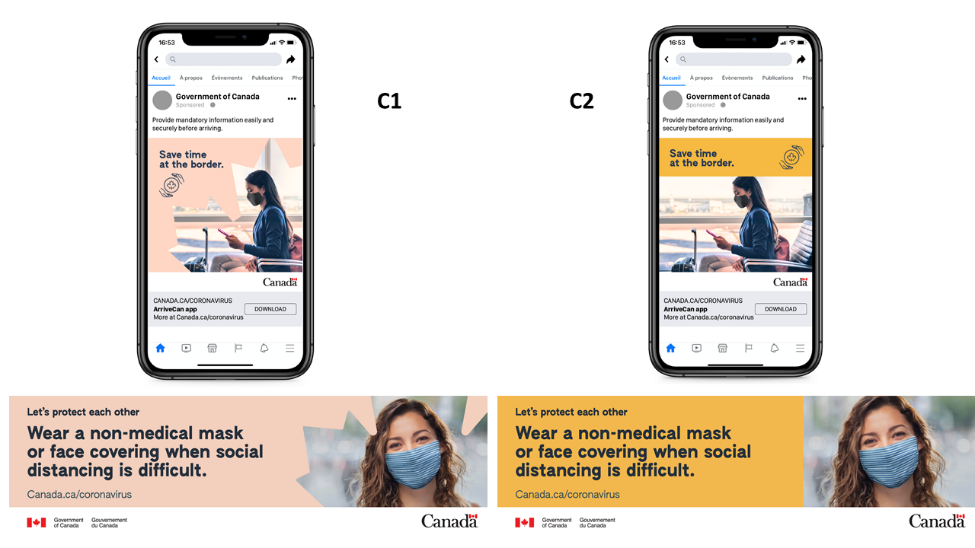
In this figure, the C1 Facebook and billboard ads are shown on the left and C2 Facebook and billboard ads shown on the right.
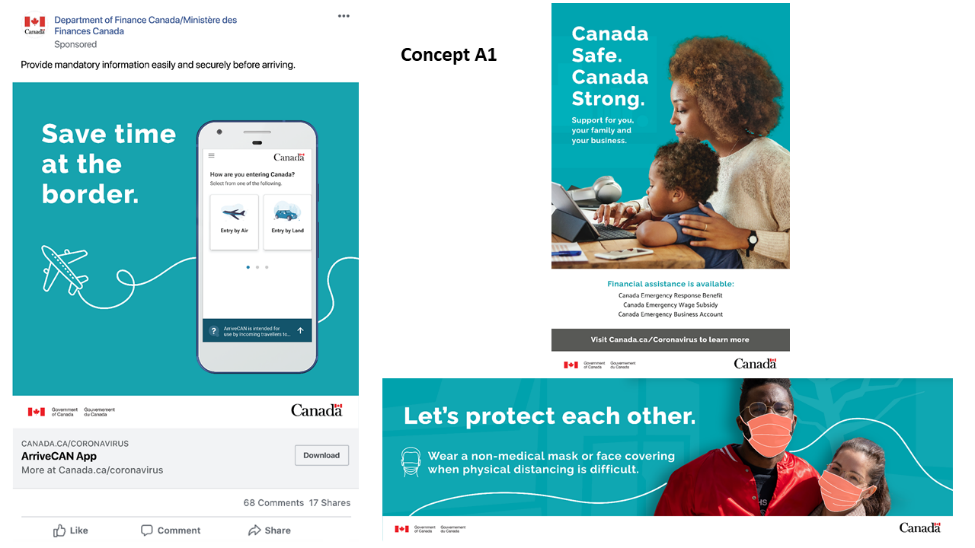
Concept A1: The figure above shows an ad set consisting of three ads over different mediums – Facebook, print and billboard ad. All ads feature a teal blue background and have a main headline in large white font. The first ad’s (Facebook) main headline (on the left) reads “Save time at the border.” along with a small icon of a plane. On the right hand side of this ad a smartphone is shown, featuring a Government of Canada ArriveCan app that reads “How are you entering Canada?” and provides two options on screen – entering by air or by land. At the bottom, there is a button to download the app or find out more information at Canada.ca/coronavirus. The second ad (print) shows a large image of a woman and her son on a computer together. On the left hand side the main headline reads “Canada Safe. Canada Strong.” and a sub-headline that reads “Support for you, your family and your business.” At the bottom of the ad, the ad reads “Financial assistance is available:” and lists the Canada Emergency Response Benefit, Canada Emergency Wage Subsidy and the Canada Emergency Business Account. Below this reads “Visit Canada.ca/Coronavirus to learn more” and the Government of Canada logo and wordmark are shown. The third ad’s (billboard) main headline reads “Let’s protect each other.” and has a sub headline that reads “Wear a non-medical mask or face covering when physical distancing is difficult.” alongside an icon of a public transit train. The right hand side of the ad features an image of a young man and woman with their arms wrapped around each other. Face masks are ‘drawn’ or overlaid on the two individuals faces. In the background there is a faint layer of trees and at the bottom of the ad, the Government of Canada logo and wordmark are shown.
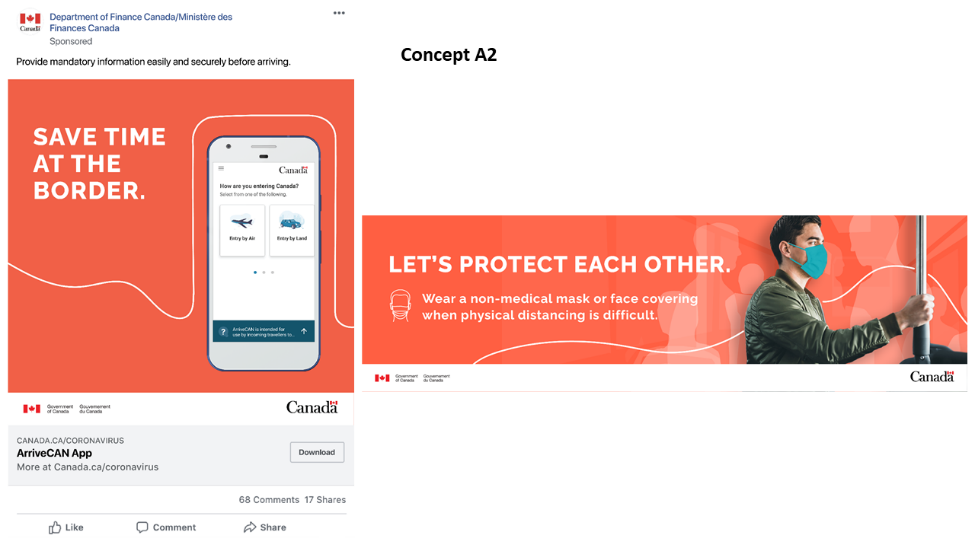
Concept A2: The figure above shows an alternative ad set consisting of two ads over different mediums – Facebook and billboard ad. All ads feature a red-orange background and have a main headline in large white font in capital letters. The first ad’s (Facebook) main headline (on the left) reads “SAVE TIME AT THE BORDER.” along with a small white line in the shape of a border. On the right hand side of this ad a smartphone is shown, featuring a Government of Canada ArriveCan app that reads “How are you entering Canada?” and provides two options on screen – entering by air or by land. At the bottom, there is a button to download the app or find out more information at Canada.ca/coronavirus. The second ad’s (billboard) main headline reads “LET’S PROTECT EACH OTHER..” and has a sub headline that reads “Wear a non-medical mask or face covering when physical distancing is difficult.” alongside an icon of a public transit train. The right hand side of the ad features an image of a young man holding a public transit pole, as if he is riding on a bus or a train. In the background, there are white shadow-like images of other people and at the bottom of the ad, the Government of Canada logo and wordmark are shown.
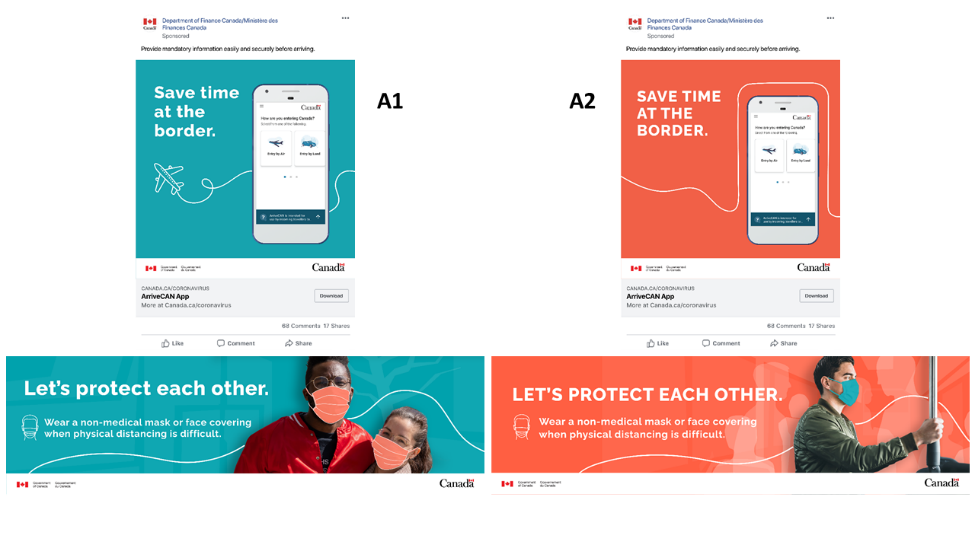
In this figure, the A1 Facebook and billboard ads are shown on the left and A2 Facebook and billboard ads shown on the right.

Concept B1: The figure above shows an ad set consisting of three ads over different mediums – Facebook, print and billboard ad. All ads feature an electric yellow, black and cream colour scheme and have a title headline and a main headline in black or white font. The first ad’s (Facebook) title headline reads “ArriveCan app” and the main headline reads “Save time at the border.” In between, there are two square images – one a photograph of a woman on a plane reading a book and tucking her hair behind her ear and another of a black icon of two hands surrounding a circle with a maple leaf in the middle, on a bright yellow background. At the bottom, there is a button to download the app with the text “More at Canada.ca/coronavirus”. The second ad (print) has the title headline at the top of the ad, which reads “CANADA SAFE. CANADA STRONG.” then, it shows a large image of a man holding his son in his arms in a home, in the centre of the page. The bottom half of the ad features the main headline (on the left) which reads “Support for you, your family and your business.” and a sub-headline on the right which reads “Financial assistance is available:” and lists the Canada Emergency Response Benefit, Canada Emergency Wage Subsidy and the Canada Emergency Business Account. At the bottom of the ad, it says “Visit Canada.ca/Coronavirus to learn more” and the Government of Canada logo and wordmark are shown. The third ad’s (billboard) title headline (on the left) reads “LET”S PROTECT EACH OTHER.” and has a sub headline that reads “Wear a non-medical mask or face covering when physical distancing is difficult.” on the left side of the ad. Below this, text with the URL canada.ca/coronavirus is presented. The right hand side of the ad features two square images – one of a young woman wearing a mask and another image of a black icon of a face mask, on a bright yellow background. At the bottom of the ad, the Government of Canada logo and wordmark are shown.
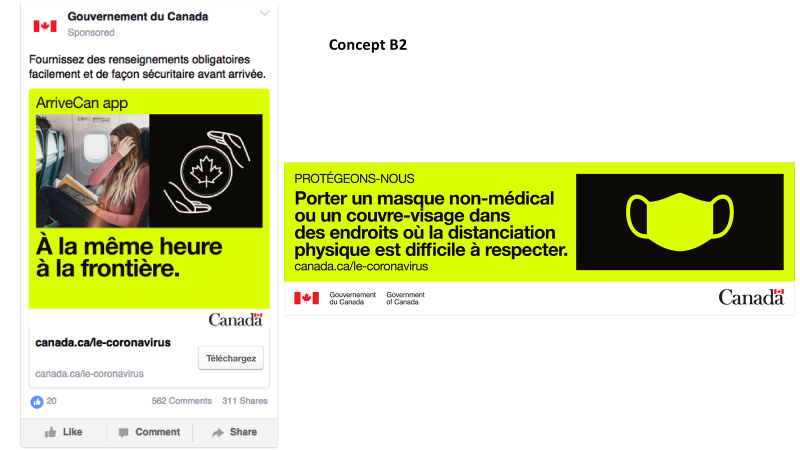
Concept B2: The figure above shows an alternative ad set consisting of two ads over different mediums – Facebook and billboard ad. All ads feature a bright yellow background and have a title headline and a main headline in large black font. The first ad’s (Facebook) title headline (across the top) reads “ArriveCan app.” and the main headline reads “Save time at the border.” In between, there are two square images – one a photograph of a woman on a plane reading a book and tucking her hair behind her ear and another of a white icon of two hands surrounding a circle with a maple leaf in the middle, on a black background. At the bottom, there is a button to download the app with the text “More at Canada.ca/coronavirus.” The second ad’s (billboard) title headline reads “LET’S PROTECT EACH OTHER.” on the left side with a main headline below that reads “Wear a non-medical mask or face covering when physical distancing is difficult.” Below this, text with the URL canada.ca/coronavirus is presented. The right hand side of the ad features an icon of a bright yellow face mask on a black background. At the bottom of the ad, the Government of Canada logo and wordmark are shown.

In this figure, the B1 Facebook and billboard ads are shown on the left and B2 Facebook and billboard ads shown on the right.
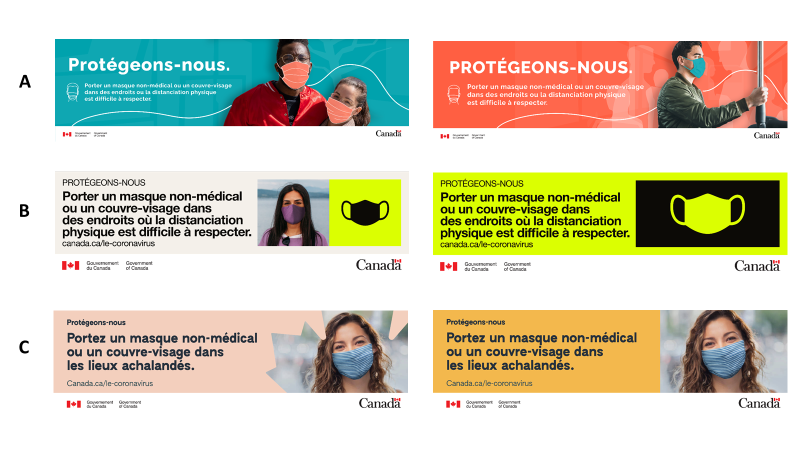
In this figure, the billboard versions of all concepts are shown in the following order (from left to right, top to bottom): A1, A2, B1, B2, C1 and C2.
| GROUP | DATE | TIME (EST) | TIME (LOCAL) | LOCATION | COMPOSITION | MODERATOR |
|---|---|---|---|---|---|---|
| 1 | July 7 | 5:30-7:30 | 5:30-7:30 EST | Windsor | Receiving CERB | D. Nixon |
| 3 | July 14 | 6:00-8:00 | 6:00-8:00 EST | Ontario – Mix of Major Centers | Black Canadians | D. Nixon |
| 4 | July 15 | 7:00-9:00 | 6:00-8:00pm CDT | Winnipeg | Parents of school age children, Gr. 7 and up | T. Woolstencroft |
| 6 | July 20 | 6:00-8:00 | 6:00-8:00 EST | GTA/ Hamilton/ Windsor | Young Adults Aged 18-24 | T. Woolstencroft |
| 7 | July 21 | 6:00-8:00 | 5:00-7:00pm MDT | Calgary (and surrounding area) | General population | T. Woolstencroft |
| 9 | July 23 | 4:30-6:30 | 5:30-7:30 ADT | Atlantic Canada – Mid-sized centers | General population | D. Nixon |
| 10 | July 27 | 6:00-8:00 | 6:00-8:00 EST | City of Toronto | General population | D. Nixon |
| 11 | July 28 | 8:30-10:30 | 5:30-7:30 pm PDT | Lower Mainland BC | General population | D. Nixon |
| LOCATION | CITIES | |
|---|---|---|
| Windsor | Windsor PARTICIPANTS SHOULD RESIDE IN THE ABOVE-NOTED CENTERS PROPER. |
CONTINUE - GROUP 1 |
| Ontario – Mix of Major Centers | Cities could include (but are not limited to): Toronto, Ottawa, Mississauga, Brampton, Hamilton ENSURE A GOOD MIX OF MAJOR CITIES ACROSS THE PROVINCE. | CONTINUE -GROUP 3 |
| Winnipeg | Winnipeg PARTICIPANTS SHOULD RESIDE IN THE ABOVE-NOTED CENTERS PROPER. |
CONTINUE -GROUP 4 |
| GTA/ Hamilton/ Windsor | Mississauga, Vaughn, Newmarket, Richmond Hill, Georgetown, Hamilton, Windsor Does not include City of Toronto ENSURE A GOOD MIX OF CITIES ACROSS THE REGION. | CONTINUE -GROUP 6 |
| Calgary (and surrounding area) | Calgary Metropolitan Area As far North as Airdrie, East as Chestermere, South as Okotoks and West as Bragg Creek | CONTINUE -GROUP 7 |
| Atlantic Canada – Mid-sized centers | Cities could include (but are not limited to): NS: Cape Breton, Sydney, Truro, New Glasgow, Kentville, NB: Dieppe, Miramichi, Bathurst NL&L: Corner Brook, Mount Pearl, Conception Bay South, Gander, Labrador City PEI: Summerside ENSURE A GOOD MIX OF MAJOR CITIES ACROSS THE REGION FROM ALL 4 PROVINCES AND KEY CENTERS. | CONTINUE -GROUP 9 |
| City of Toronto |
City of Toronto PARTICIPANTS SHOULD RESIDE IN THE ABOVE-NOTED CENTERS PROPER. |
CONTINUE -GROUP 10 |
| Lower Mainland BC | Cities could include (but are not limited to): Abbotsford, Burnaby, Chilliwack, Coquitlam, Delta, Hope, Langley, Maple Ridge, Mission, New Westminster, North Vancouver, Port Coquitlam, Port Moody Richmond, Surrey, Vancouver, Whistler ENSURE A GOOD MIX OF CITIES ACROSS THE REGION. INCLUDE THOSE RESIDING IN LARGER AND SMALLER COMMUNITIES. | CONTINUE -GROUP 11 |
| Other | - | THANK AND END |
| VOLUNTEERED Prefer not to answer | - | THANK AND END |
| Less than two years | THANK AND END |
|---|---|
| Two years or more | CONTINUE |
| Don’t know/Prefer not to answer | THANK AND END |
| Child | Grade |
|---|---|
| 1 | |
| 2 | |
| 3 | |
| 4 | |
| 5 |
| Under 18 years of age | IF POSSIBLE, ASK FOR SOMEONE OVER 18 AND REINTRODUCE. OTHERWISE THANK AND END. |
|---|---|
| 18-24 | IF GTA/HAMILTON/WINDSOR = GROUP 6 ALL OTHER LOCATIONS, CONTINUE |
| 25-34 | IF GTA/HAMILTON/WINDSOR = THANK AND END ALL OTHER LOCATIONS, CONTINUE |
| 35-44 | |
| 45-54 | |
| 55+ | |
| VOLUNTEERED Prefer not to answer |
THANK AND END |
| GROUPE | DATE | HEURE (DE L’EST) | LIEU | COMPOSITION DU GROUPE | MODÉRATEUR |
|---|---|---|---|---|---|
| 2 | 9 juillet | 18 h-20 h | Région métropolitaine de Montréal – y compris Montréal même | Canadiens noirs | M. Proulx |
| 5 | 16 juillet | 17 h 30-19 h 30 | Communautés rurales du Québec | Bénéficiaires de la PCU | M. Proulx |
| 8 | 22 juillet | 18 h-20 h | Montréal | Population générale | M. Proulx |
| 12 | 29 juillet | 18 h-20 h | Villes de taille moyenne et petites villes du Québec | Parents ayant des enfants d’âge scolaire (prématernelle/maternelle jusqu’à la 6e année) | M. Proulx |
| LIEU | VILLES | |
|---|---|---|
| Région métropolitaine de Montréal – y compris Montréal même | Montréal, Laval, Longueuil, Terrebonne, Brossard, Repentigny, Saint-Jérôme, Blainville, Mirabel, Dollard-des-Ormeaux, etc. ASSURER UNE BONNE REPRÉSENTATION DES VILLES DANS CHAQUE LIEU. |
CONTINUER – GROUPE 2 |
| Communautés rurales du Québec | Moins de 25 000 habitants Non adjacentes à de grands centres (comme les régions métropolitaines de recensement de Montréal ou de Québec) ASSURER UNE BONNE REPRÉSENTATION DES VILLES DANS CHAQUE LIEU. | CONTINUER – GROUPE 5 |
| Montréal | Montréal LES PARTICIPANTS DOIVENT RÉSIDER DANS LESDITS CENTRES. |
CONTINUER – GROUPE 8 |
| Villes de taille moyenne et petites villes du Québec | Villes de taille moyenne : 100 000 à 300 000 habitants Petites villes : 25 000 à 100 000 habitants (comme les régions métropolitaines de recensement de Montréal ou de Québec) ASSURER UNE BONNE REPRÉSENTATION DES VILLES DANS CHAQUE LIEU. |
CONTINUER – GROUPE 12 |
| Autre lieu | - | REMERCIER ET CONCLURE |
| RÉPONSE SPONTANÉE Préfère ne pas répondre | - | REMERCIER ET CONCLURE |
| Moins de deux ans | REMERCIER ET CONCLURE |
|---|---|
| Deux ans ou plus | CONTINUER |
| Ne sais pas/Préfère ne pas répondre | REMERCIER ET CONCLURE |
Oui CONTINUER
Non REMERCIER ET CONCLURE
Ne sais pas/Préfère ne pas répondre REMERCIER ET CONCLURE
En avril CONTINUER
En mai CONTINUER
Ne sais pas/Préfère ne pas répondre CONTINUER
Oui CONTINUER
Non REMERCIER ET CONCLURE
RÉPONSE SPONTANÉE Préfère ne pas répondre REMERCIER ET CONCLURE
| Enfant | Année |
|---|---|
| 1 | |
| 2 | |
| 3 | |
| 4 | |
| 5 |
| Moins de 18 ans | SI POSSIBLE, DEMANDER À PARLER À UNE PERSONNE DE 16 ANS OU PLUS ET REFAIRE L’INTRODUCTION. SINON, REMERCIER ET CONCLURE. |
|---|---|
| 18 à 24 | CONTINUER |
| 25 à 34 | |
| 35 à 44 | |
| 45 à 54 | |
| 55 ans ou plus | |
| RÉPONSE SPONTANÉE Préfère ne pas répondre | REMERCIER ET CONCLURE |







The figures above show a series of Facebook ads. The ad sponsor for all ads is Healthy Canadians and the Health Canada and Government of Canada logo are included at the bottom of each ad. Each ad also contains a call to action at the bottom that reads “Help us stop COVID-19. Download the COVID Alert app” and includes a button to “Download” the app. Each concept (A to G) contains a different post headline and different main image.
A: Post headline: We need your help to contain the virus. Download the COVID Alert app so that, together, we can limit the spread of COVID-19. Main image has a green background. Main headline (in image): Help stop the spread. Download the COVID Alert app. Icon (in image): Hand holding a cell phone with COVID Alert app logo on screen.
B: Post headline: We need you to do your part to contain the contain virus. Download the COVID Alert app so that, together, we can limit the spread of COVID-19. Main image has a blue background. Main headline (in image): Do your part. Download the COVID Alert app. Icon (in image): A person with a beard is holding a cell phone that is sending an alert. The COVID Alert app logo is shown in a speech bubble.
C: Post headline: Let’s keep protecting ourselves and others. Download the COVID Alert app so that, together, we can limit the spread of COVID-19. Main image has a yellow background. Main headline (in image): Download the COVID Alert app. Protect your community. Icon (in image): Two different hands each holding a cell phone with COVID Alert app logo on screen. There is a network signal that connects the two phones together.
D: Post headline: Break the chain of infection while protecting your privacy. Download the COVID Alert app so that, together, we can limit the spread of COVID-19. Main image has a pink background. Main headline (in image): We protect your privacy so you can protect others. Icon (in image): A person with long hair is holding a cell phone that is sending an alert. The COVID Alert app logo is shown in a speech bubble.
E: Post headline: Protect yourself and your loved ones by knowing if you’ve been exposed. Download the COVID Alert app so that, together, we can limit the spread of COVID-19. Main image has an orange background. Main headline (in image): Use the COVID Alert app to know if you may have been exposed. Icon (in image): A person with an afro is holding a cell phone that is sending an alert. The COVID Alert app logo is shown in a speech bubble.
F: Post headline: Get tested if someone you’ve been near reports positive for the virus. Download the COVID Alert app so that, together, we can limit the spread of COVID-19. Main image has a purple background. Main headline (in image): Download the COVID Alert app before heading out. Icon (in image): A person with short hair is holding a cell phone with a notification symbol. The COVID Alert app logo is shown in a speech bubble.
G: Post headline: Go further than wearing a mask to protect yourself and others. Download the COVID Alert app so that, together, we can limit the spread of COVID-19. Main image has a seafoam green coloured background. Main headline (in image): Get extra protection. Use both a mask and the COVID Alert app. Icon (in image): A person with short hair, wearing a mask, is holding a cell phone that is sending an alert. The COVID Alert app logo is shown in a speech bubble.




The four figures above show a series of screenshots, in sequential order that Canadians would see on the COVID Alert app. Each frame has a ‘Close’ button on the top right, an image, headline and sub-text in the main frame, and at the bottom, there is a progress bar along with ‘Back’ and ‘Next’ buttons to move through from page to page.
1. This image shows a cell phone in a person’s pocket (in purple) that has a sync icon on the screen. Next to the cell phone is a rectangle block of arrows coming into the phone and away from the cell phone (in green). Headline: How COVID Alert works. Sub-text: The app runs in the background and will not interrupt your activities. Whenever you’re near someone else with COVID Alert, both phones exchange random codes every 5 minutes. The random codes change often and cannot be used to identify you.
2. This image shows two cell phones (in purple) connected by a dotted line above with a timer icon in the middle. Above this is a sign (in green) with a dotted double arrow icon. Headline: What’s an exposure? Sub-text: The app estimates how near people are from the strength of Bluetooth signals. If you’re closer than 2 metres for more than 15 minutes, the app will record an exposure.
3. This image shows a cell phone (in purple) with an export icon on the screen. Above this is a rectangle (in green) that shows the code 101101. Above this is an icon of a white cloud. Headline: Getting a positive test. Sub-text: If someone with the app is diagnosed with COVID-19, they can choose to upload the random codes their phone sent. The codes go into a central server. The server only gets the codes. It does not get any information about the person.
4. This image shows a cell phone (in purple) at the bottom. Above the phone is a vertical rectangle (in green) with codes 00100, 01101, 01101. Over the middle code (01101) is a search bar. Headline: Looking for exposures. Sub-text: Every day, whenever it has an Internet connection, your phone will get a list of the random codes from people who reported a diagnosis. If it finds codes that match, the app notifies you that you’ve been exposed and gives you guidance.

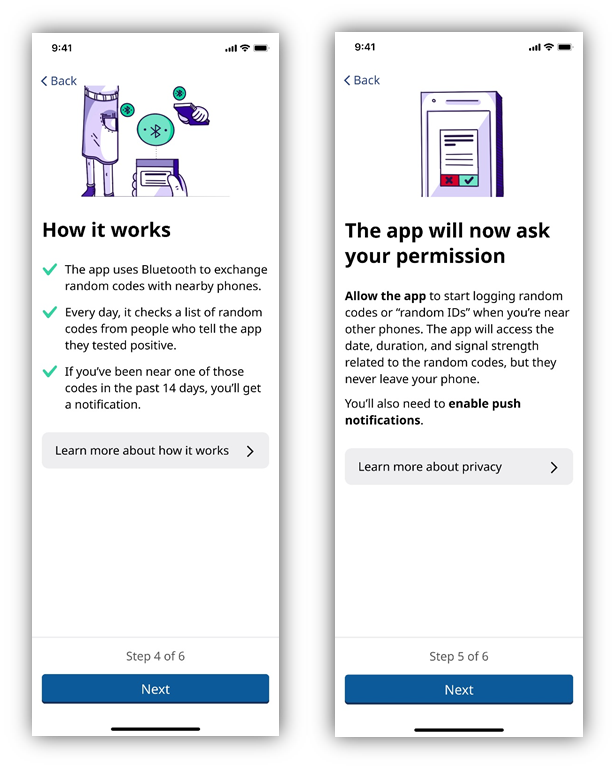
The five figures above show a series of screenshots, in sequential order, that Canadians would first see when they download and open the COVID Alert app. Each frame has an image, headline and sub-text in the main frame. At the bottom, there is a progress statement (e.g. Step 1 of 6), along with a ‘Next’ button to move to the next page.
1. This image shows the top of a cell phone (in purple) with icons of people doing different activities above. Headline: Together, let’s stop the spread of COVID-19. Sub-text: COVID Alert helps us break the cycle of infection. The app can let people know of possible exposures before any symptoms appear. That way, we can take care of ourselves and protect our communities.
2. This image shows icons of a corporate building, an apartment building and several houses all connected. Headline: What COVID Alert does not do. Sub-text: The app will not tell you in the moment if you’re currently near someone who’s been diagnosed. It will not tell you about outbreaks in your community.
3. This image shows a silhouette of a person’s face using icons of a hat and glasses (in purple). Above this, is a location services symbol (in red) with an ‘X” through it. Headline: Totally anonymous. Sub-text: COVID Alert does not use GPS or location services. It has no way of knowing: X Your location. X Your name or address. X Your phone’s contacts. X Your health information.
4. This image shows two people holding cell phones and a person with a cell phone in their pockets (in purple). Above each cell phone is a Bluetooth icon (in green). Headline: How it works. Sub-text: ✓ The app uses Bluetooth to exchange random codes with nearby phones. ✓ Every day, it checks a list of random codes from people who tell the app they tested positive. ✓ If you’ve been near one of those codes in the past 14 days, you will get a notification. At the bottom of the frame there is a button that reads ‘Learn more about how it works’ with a forward arrow.
5. This image shows a cell phone (purple). On screen, is a series of text with an ‘X’ (in red) and a ‘✓” (in green) at the bottom. Headline: The app will now ask your permission. Sub-text: Allow the app to start logging random codes or “random IDs” when you’re near other phones. The app will access the date, duration, and signal strength related to the random codes, but they never leave your phone. You’ll also need to enable push notifications. At the bottom of the frame there is a button that reads ‘Learn more about privacy’ with a forward arrow.

Concept A1: The figure above shows an ad set consisting of three ads over different mediums – Facebook, print and billboard ad. All ads feature a teal blue background and have a main headline in large white font. The first ad’s (Facebook) main headline (on the left) reads “Save time at the border.” along with a small icon of a plane. On the right hand side of this ad a smartphone is shown, featuring a Government of Canada ArriveCan app that reads “How are you entering Canada?” and provides two options on screen – entering by air or by land. At the bottom, there is a button to download the app or find out more information at Canada.ca/coronavirus. The second ad (print) shows a large image of a woman and her son on a computer together. On the left hand side the main headline reads “Canada Safe. Canada Strong.” and a sub-headline that reads “Support for you, your family and your business.” At the bottom of the ad, the ad reads “Financial assistance is available:” and lists the Canada Emergency Response Benefit, Canada Emergency Wage Subsidy and the Canada Emergency Business Account. Below this reads “Visit Canada.ca/Coronavirus to learn more” and the Government of Canada logo and wordmark are shown. The third ad’s (billboard) main headline reads “Let’s protect each other.” and has a sub headline that reads “Wear a non-medical mask or face covering when physical distancing is difficult.” alongside an icon of a public transit train. The right hand side of the ad features an image of a young man and woman with their arms wrapped around each other. Face masks are ‘drawn’ or overlaid on the two individuals faces. In the background there is a faint layer of trees and at the bottom of the ad, the Government of Canada logo and wordmark are shown.

Concept A2: The figure above shows an alternative ad set consisting of two ads over different mediums – Facebook and billboard ad. All ads feature a red-orange background and have a main headline in large white font in capital letters. The first ad’s (Facebook) main headline (on the left) reads “SAVE TIME AT THE BORDER.” along with a small white line in the shape of a border. On the right hand side of this ad a smartphone is shown, featuring a Government of Canada ArriveCan app that reads “How are you entering Canada?” and provides two options on screen – entering by air or by land. At the bottom, there is a button to download the app or find out more information at Canada.ca/coronavirus. The second ad’s (billboard) main headline reads “LET’S PROTECT EACH OTHER..” and has a sub headline that reads “Wear a non-medical mask or face covering when physical distancing is difficult.” alongside an icon of a public transit train. The right hand side of the ad features an image of a young man holding a public transit pole, as if he is riding on a bus or a train. In the background, there are white shadow-like images of other people and at the bottom of the ad, the Government of Canada logo and wordmark are shown.

Concept B1: The figure above shows an ad set consisting of three ads over different mediums – Facebook, print and billboard ad. All ads feature an electric yellow, black and cream colour scheme and have a title headline and a main headline in black or white font. The first ad’s (Facebook) title headline reads “ArriveCan app” and the main headline reads “Save time at the border.” In between, there are two square images – one a photograph of a woman on a plane reading a book and tucking her hair behind her ear and another of a black icon of two hands surrounding a circle with a maple leaf in the middle, on a bright yellow background. At the bottom, there is a button to download the app with the text “More at Canada.ca/coronavirus”. The second ad (print) has the title headline at the top of the ad, which reads “CANADA SAFE. CANADA STRONG.” then, it shows a large image of a man holding his son in his arms in a home, in the centre of the page. The bottom half of the ad features the main headline (on the left) which reads “Support for you, your family and your business.” and a sub-headline on the right which reads “Financial assistance is available:” and lists the Canada Emergency Response Benefit, Canada Emergency Wage Subsidy and the Canada Emergency Business Account. At the bottom of the ad, it says “Visit Canada.ca/Coronavirus to learn more” and the Government of Canada logo and wordmark are shown. The third ad’s (billboard) title headline (on the left) reads “LET”S PROTECT EACH OTHER.” and has a sub headline that reads “Wear a non-medical mask or face covering when physical distancing is difficult.” on the left side of the ad. Below this, text with the URL canada.ca/coronavirus is presented. The right hand side of the ad features two square images – one of a young woman wearing a mask and another image of a black icon of a face mask, on a bright yellow background. At the bottom of the ad, the Government of Canada logo and wordmark are shown.
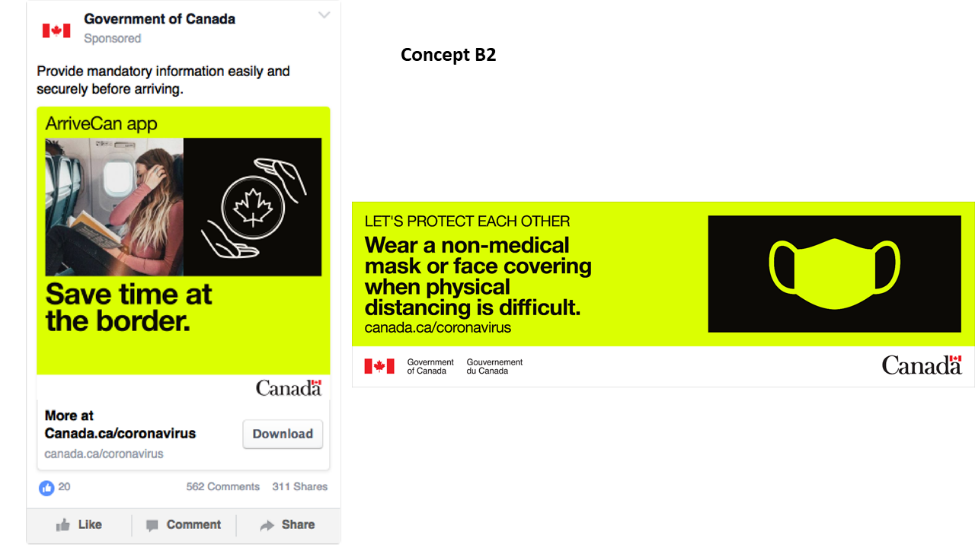
Concept B2: The figure above shows an alternative ad set consisting of two ads over different mediums – Facebook and billboard ad. All ads feature a bright yellow background and have a title headline and a main headline in large black font. The first ad’s (Facebook) title headline (across the top) reads “ArriveCan app.” and the main headline reads “Save time at the border.” In between, there are two square images – one a photograph of a woman on a plane reading a book and tucking her hair behind her ear and another of a white icon of two hands surrounding a circle with a maple leaf in the middle, on a black background. At the bottom, there is a button to download the app with the text “More at Canada.ca/coronavirus.” The second ad’s (billboard) title headline reads “LET’S PROTECT EACH OTHER.” on the left side with a main headline below that reads “Wear a non-medical mask or face covering when physical distancing is difficult.” Below this, text with the URL canada.ca/coronavirus is presented. The right hand side of the ad features an icon of a bright yellow face mask on a black background. At the bottom of the ad, the Government of Canada logo and wordmark are shown.

Concept C1: The figure above shows an ad set consisting of three ads over different mediums – Facebook, print and billboard ad. All ads feature a peach and light grey background colour and have a main headline in large black font. The first ad’s (Facebook) main headline (on the left) reads “Save time at the border.” along with a small icon of two hands surrounding a circle with a maple leaf in the middle. The right side of the ad features a photograph of a woman wearing a mask in an airport, which is framed by a maple leaf. At the bottom, there is a button to download the app or find out more information at Canada.ca/coronavirus. The second ad (print) shows (on the right) a large image of a man sitting while holding his two children, which is framed by a partial maple leaf. On the left hand side the main headline reads “Canada Safe. Canada Strong.” and a larger sub headline below reads “Support for you, your family and your business.” Underneath this, is smaller text that reads “Financial assistance is available:” and lists the Canada Emergency Response Benefit, Canada Emergency Wage Subsidy and the Canada Emergency Business Account. At the bottom of the ad the text “Visit Canada.ca/Coronavirus to learn more” and the Government of Canada logo and wordmark are shown. The third ad’s (billboard) main headline reads “Let’s protect each other” and has a sub headline that reads “Wear a non-medical mask or face covering when physical distancing is difficult.” Below this, text with the URL canada.ca/coronavirus is presented. The right hand side of the ad features a photograph of a young man smiling as she is wearing a mask, which is framed by the outline of a maple leaf. At the bottom of the ad, the Government of Canada logo and wordmark are shown.

Concept C2: The figure above shows an alternative ad set consisting of two ads over different mediums – Facebook and billboard ad. All ads feature an orange background and have a title headline and/or a main headline in large black font. The first ad’s (Facebook) the main headline reads “Save time at the border.” (on the right) and a black icon of two hands surrounding a circle with a maple leaf in the middle (on the right). Underneath, taking up most of the ad, is a rectangular photograph of a woman wearing a mask in an airport. At the bottom, there is a button to download the app with the text “ArriveCan app” and “More at Canada.ca/coronavirus.” The second ad’s (billboard) title headline reads “Let’s protect each other.” (on the left side) with a main headline below that reads “Wear a non-medical mask or face covering when physical distancing is difficult.” Below this, text with the URL Canada.ca/coronavirus is presented. The right hand side of the ad features a square photograph of a young man smiling as she is wearing a mask. At the bottom of the ad, the Government of Canada logo and wordmark are shown.